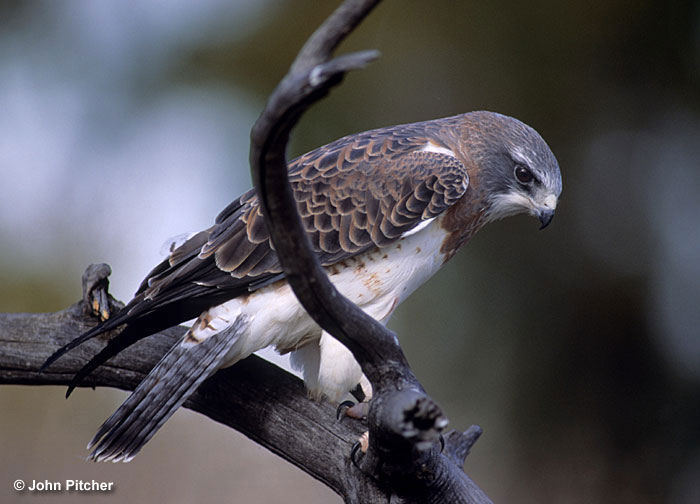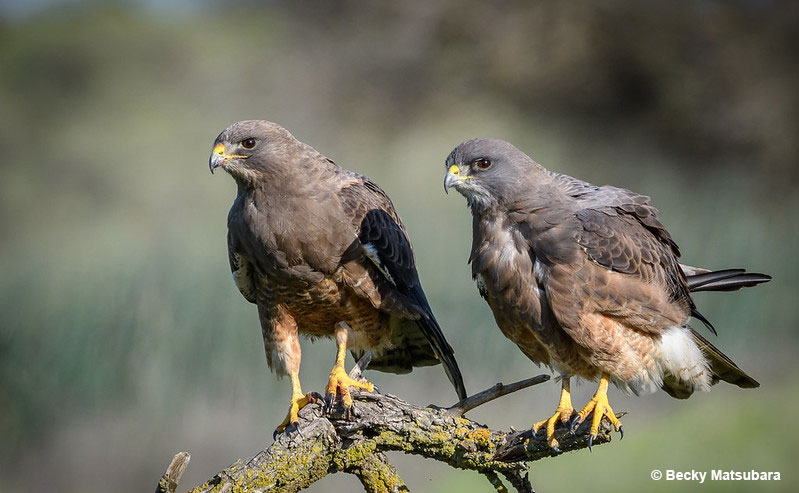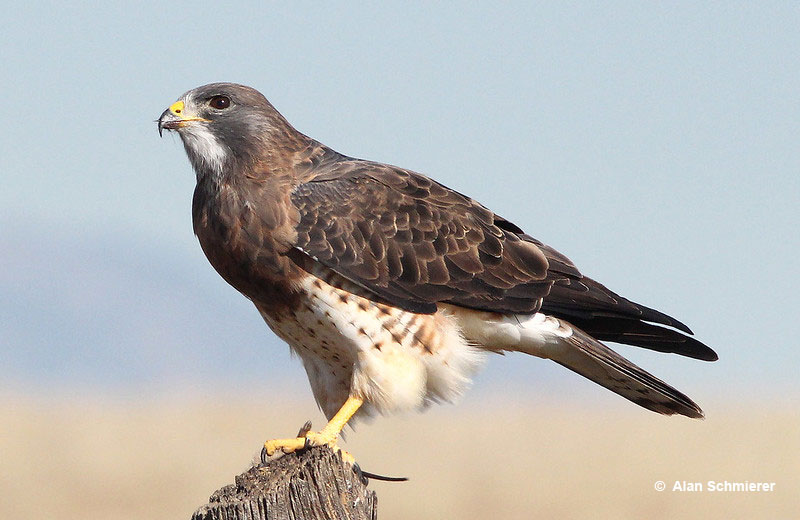Meet Swainson’s Hawks, a captivating and enigmatic species that captures the imagination of bird enthusiasts and scientists alike.
These magnificent raptors, known for their impressive aerial acrobatics and incredible migratory journeys, embody the beauty and resilience of nature’s winged wonders.
From their distinct plumage to their remarkable migration patterns, these hawks have become a subject of fascination and research for ornithologists and conservationists worldwide.
On this page
Identification
Swainson’s Hawks have reddish-brown or dark chests, gray or brown upper parts, and are light-bellied. They have distinct underwings contrasting greatly with the blackish flight feathers and white wing linings.
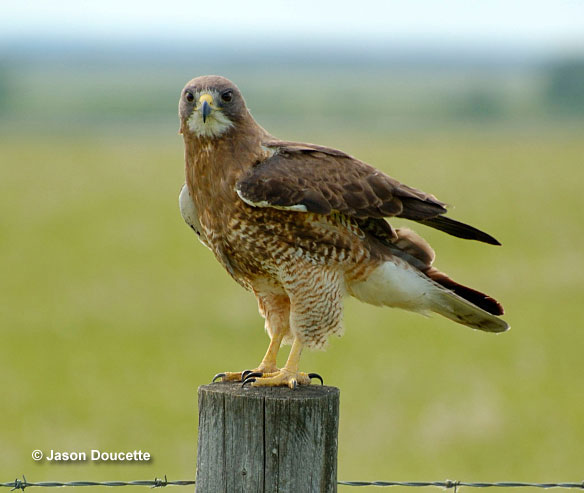
Most male Swainson’s Hawks have gray heads. However, dark individuals do occur; these vary from nearly all black to reddish, with less contrast on the underwings. They’re smaller than a Ferruginous Hawk and larger than a Cooper’s Hawk.
Female Swainson’s Hawks look almost identical to Male Swainson’s Hawks. They have distinct underwings that contrast greatly with the blackish flight feathers and white wing linings.
Juvenile Swainson’s Hawks have a scalloped appearance thanks to the pale edges to the upper wing coverts. Light-morph juveniles have varying streaking on their breasts, pale edges to the wing coverts, and are mottled brown above. Their heads are often pale from bleaching.
Dark-morph juveniles can vary significantly in terms of darkness. They usually have pale under-tail coverts and buffy streaking on the body.
Food
Swainson’s Hawks primarily consume insects and mammals. Mammals make up the majority of their diet during the breeding season when adults prey on gophers, ground squirrels, mice, rabbits, and voles.
These birds are opportunistic feeders meaning they’ll consume a variety of foods and adapt to readily available food. Because of this, Swainsn’s Hawks have been known to consume snakes, bats, birds, and lizards.
Regionally, their diets vary significantly. For example, a major part of these birds’ diet in a region near Alberta was Burrowing Owls. In Utah, rabbits were more than half of the prey these birds consumed.
Out of breeding season, Swainson’s Hawks almost wholly rely on insects, especially grasshoppers, dragonflies, and crickets, often capturing and eating them in flight. They also eat beetles, moths, and butterflies.
Nesting and Eggs
Male Swainson’s Hawks are the ones to choose the nesting site. The site is usually in a small grove of trees along a stream or near the top of a solitary tree.
Mated pairs typically create nests in shelterbelts or other trees that are located near pastures and agricultural fields where they feed.
In the southern part of their range, these birds will create nests only three feet off the ground in mesquite bushes. Additionally, they’ll sometimes nest on a transmission tower or power pole.
Although both the male and female will build the nest together, the male is the one to bring most of the materials. Nest construction usually takes around 2 weeks. After completion, the nest is generally over 12 inches tall and 2 feet wide.
The inner bowl of the nest measures up to 2.75 inches tall and 8 inches wide. Both partners will line the bowl of the nest with grass, fresh, leafy twigs, hay, bark, and weed stalks; the lining can also include wool or cow dung.
Swainson’s Hawks generally have 1 to 5 eggs, they incubate them for around 35 days. The young hawks stay in the nest or around 22 days.
Current Situation
According to IUCN Red List, Swainson’s Hawk’s numbers are stable and marked as low-concern species.
There was a historic decline in this species because farmers would shoot this hawk species and others because they believed they harmed livestock. However, shooting these birds is now illegal. The recent decline in numbers is due to a loss of nesting sites and prey.
Additionally, the conversion of pastureland to soybean fields in Argentina has led these birds to lose their winter foraging habitats.
Certain pesticides used in these fields to control grasshoppers killed thousands of these wintering birds in the 1990s. The banning of these pesticides and education have apparently been successful in reducing the mortality of Swainson’s Hawks. However, other pesticides are still a threat.
Swainson’s Hawks prefer to inhabit open areas that are ideal for foraging. Although much of their native grassland and prairie habitats have been converted to grazing and cropland, these birds have adjusted considerably well to these agricultural settings.
You’ll find them searching for prey in alfalfa fields and hay, row crops, grain crops, and pastures or perched on top of overhead sprinkler systems and adjacent fence posts.
Facts
- Swainson’s Hawks feed their young the “three r’s”: reptiles, rabbits, and rodents. However, when they’re not breeding, the adults have a diet primarily consisting of insects, especially dragonflies and grasshoppers.
- The Swainson’s Hawk got its name from William Swainson, who was a British naturalist.
- The oldest recorded Swainson’s Hawk lived to be at least 26 years and 1 month old. It was banded in California in the late 1980s, then recaptured during banding operations and rereleased in the same state in 2012.
- Swainson’s hawks are most likely the longest raptor migrants in North America. Their flight from the breeding ground to wintering grounds can be as long as 7,100 mi (11,400 km).
Similar Species
The Swainson’s Hawk has features that are similar to other birds. Here are some similar species:
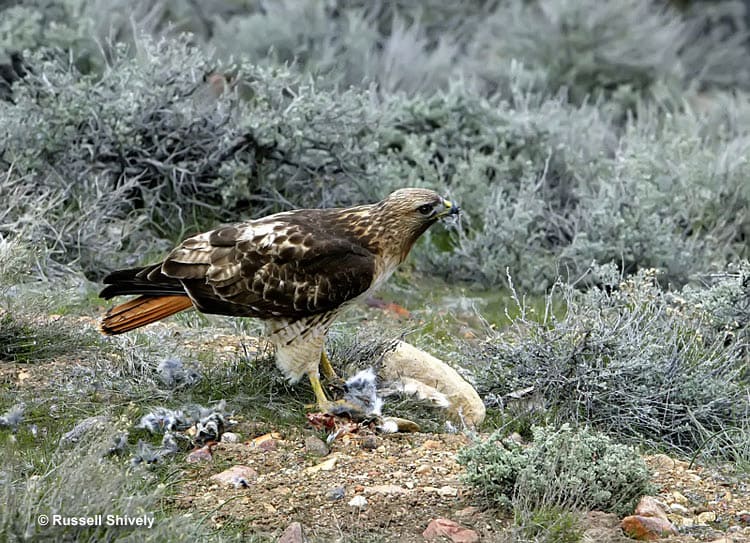
Red-tailed Hawk
Swainson’s Hawks have darker, narrow wings in comparison to Red-tailed Hawks.
Additionally, Red-tailed Hawks have dark streaks on their belly, mostly white breasts, and dark patches on the leading edge between the wrist and shoulder.
They also lack a large brown head.
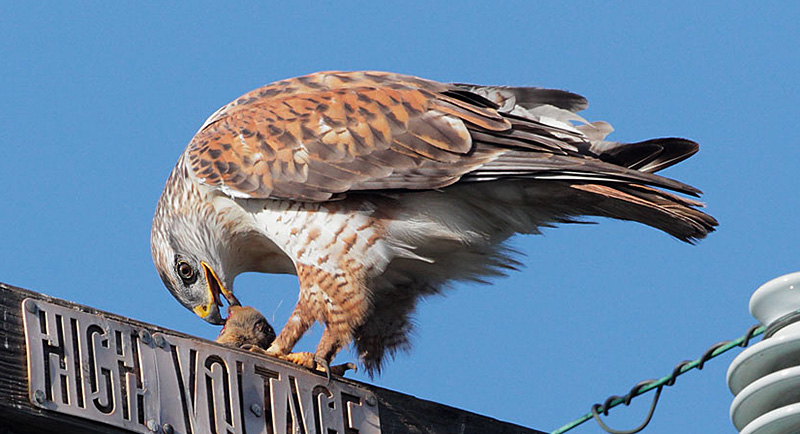
Ferruginous Hawk
Swainson’s Hawks have dark trailing on the edge of the wing and a brown hood.
Ferruginous Hawks are pale underneath and lack both of those features.
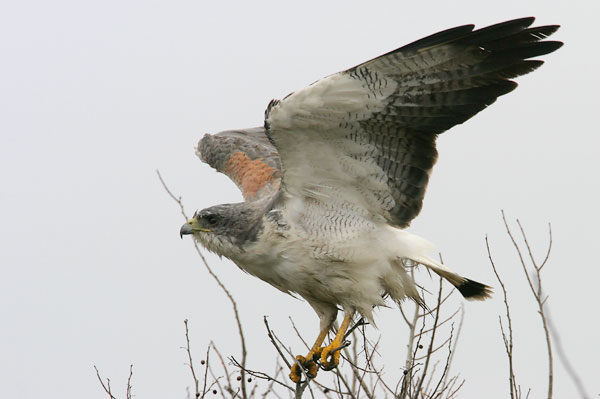
White-tailed Hawk
Swainson’s Hawks have thin dark bands on the tail, while White-tailed Hawks have strong black bands at the end of their tails.
Additionally, White-tailed Hawks lack the brown on the upper breast that Swainson’s Hawks have.
Frequently Asked Questions
Are Swainson’s Hawks rare?
No, the Swainson’s Hawk is not rare. These birds have a decent range and a stable population.
How do you identify a Swainson’s Hawk?
Though plumage can vary significantly on these birds, most Swainson’s Hawks have reddish-brown or dark chests, gray or brown upper parts, and are light-bellied. They have distinct underwings that contrast greatly with the blackish flight feathers and white wing linings. Most male Swainson’s have gray heads. However, dark individuals do occur; these vary from nearly all black to reddish, with less contrast on the underwings. Female Swainson’s Hawks look almost identical to Male Swainson’s Hawks, except females usually have brown heads.
How big are Swainson’s Hawks?
The Swainson’s hawk has narrow wings and a thin body. It is 18.9 to 22 inches (48 to 56 centimeters) long and weighs between 1.5 and 3 pounds (693 and 1367 grams).
How big is Swainson’s Hawk’s wingspan?
Swainson’s Hawks have a wingspan of 46 to 54 inches (117 to 137 centimeters).

